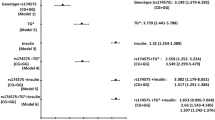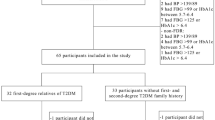Abstract
Background:
Recently, it has been shown that the polymorphism 385 C/A of FAAH (fatty acid amide hydrolase) was associated with overweight and obesity. Visfatin has been identified as a protein expressed in visceral adipose tissue with contradictory functions in glucose metabolism.
Objective:
The aim of our study was to investigate the relationship between polymorphism (cDNA 385 C->A) of the FAAH gene and visfatin levels in obese women.
Design:
A population of 143 females with obesity was analyzed. Indirect calorimetry, tetrapolar electrical bioimpedance, blood pressure and serial assessment of nutritional intake with 3-day written food records and biochemical analysis (lipid profile, visfatin, insulin, C-reactive protein and homeostasis model assessment for insulin sensitivity (HOMA)) were performed.
Results:
Ninety-four patients (65.7%) had the genotype C358C (wild-type group) and 49 (34.3%) patients had the genotype C358A (mutant type group). No differences were detected between groups in anthropometric parameters and dietary intakes. Insulin (15.6±7.6 vs 14.1±10.1 mUI l−1; P<0.05), glucose (101.2±21.9 vs 92.3±10.5 mg per 100 ml; P<0.05) and HOMA values (3.96±2.3 vs 3.15±2.8; P<0.05) were higher in the wild type-group than in the mutant type group. Visfatin levels were lower in the wild-type group than in the mutant type group (47.83±57.5 vs 65.71±55 ng ml−1; P<0.05).
Conclusion:
The novel finding of this study is the association of the mutant type group A358C of FAAH with lower glucose, insulin and HOMA levels than of the wild-type group with higher visfatin levels.
This is a preview of subscription content, access via your institution
Access options
Subscribe to this journal
Receive 12 print issues and online access
$259.00 per year
only $21.58 per issue
Buy this article
- Purchase on Springer Link
- Instant access to full article PDF
Prices may be subject to local taxes which are calculated during checkout
Similar content being viewed by others
References
Fukuhara A, Matsuda M, Nishizawa M, Sagawa K, Tanaka M, Kishimoto K et al. Visfatin: a protein secreted by visceral fat that mimics the effects of insulin. Science 2005; 307: 426–430.
Ognjanovic S . Genomic organization of the gene coding for human pre-B-cell colony enhancing factor and expression in human fetal membranes. J Mol Endocrinol 2001; 26: 107–117.
Deustch DG, Ueda N, Yammamoto S . The fatty acid amide hydrolase (FAAH) 1. Prostaglandins Leukot Essent Fatty Acids 2002; 66: 201–210.
Lichtman AH, Hawkins EG, Griffin G, Cravatt BF . Pharmacological activity of fatty acid amides is regulated, but not mediated, by fatty acid amide hydrolase in vivo. Pharmacol Exp Ther 2002; 302: 73–79.
Matsuzawa Y . Adipocytokines: emerging therapeutic targets. Curr Atheros Rep 2005; 7: 58–62.
Ameri A . The effects of cannabinnoids on the brain. Prog Neurobiol 1999; 58: 315–348.
Fride E . Endocannabinoids in the central nervous system an overview. Prostaglandins Leukot Essent Fatty acids 2002; 66: 221–233.
Sipe JC, Chiang K, Gerber AL, Beutler E, Cravatt BF . A Missense mutation in human fatty acid amide hydroxylase associated with problem drug abuse. Proc Natl Acad Sci USA 2002; 99: 8394–8399.
Sipe JC, Waalen J, Gerber A, Beutler E . Overweight and obesity associated with a missense polymorphism in fatty acid amide hydrolase (FAAH). Int J of Obes 2005; 29: 755–759.
Monteleone P, Tortorella A, Martiadis V, Filippo C, Canestrelli B, Maj M . The CDNA 385 C to A missense polymorphism of the endocannabinoid degrading enzyme fatty acid amide hydrolase (FAAH) os associated with overweight/obesity but not with binge eating disorder in overweight/obese women. Psychoneuroendocrinology 2008; 33: 546–550.
Jensen D, Andreasen C, Andersen M, Hansen L, Eiberg H, Borch-Johnsen K et al. The functional pro129Thr variant of the FAAH gene is not associated with various fat accumulation phenotypes in a population-based cohort of 5801 whites. J Mol med 2007; 85: 445–449.
Duart MJ, Arroyo CO, Moreno JL . Validation of a insulin model for the reactions in RIA. Clin Chem Lab Med 2002; 40: 1161–1167.
Mathews DR, Hosker JP, Rudenski AS, Naylor BA, Treacher DF . Homesotasis model assessment: insulin resistance and beta cell function from fasting plasma glucose and insulin concentrations in man. Diabetologia 1985; 28: 412–414.
Friedewald WT, Levy RI, Fredrickson DS . Estimation of the concentration of low-density lipoprotein holesterol in plasma, without use of the preparative ultracentrifuge. Clin Chem 1972; 18: 499–502.
Feurer ID, Mullen JL . Bedside measurement of resting energy expenditure and respiratory quotient via indirect calorimetry. Nutr Clin Pract 1986; 1: 43–49.
Pichard C, Slosman D, Hirschel B, Kyle U . Bioimpedance analysis: an improved method for nutritional follow up. Clin Res 1993; 41: 53.
Mataix J, Mañas M . Tablas de composición de alimentos españoles. University of Granada: Granada, 2003.
Chiang KP, Gerber AL, Sipe JC, Cravatt BF . Reduced cellular expression and activity of the P129T mutant fatty acid amide hydrolase: evidence for a link between defects in the endocannabinoid system and problem drug use. Hum Mol Genet 2004; 13: 2113–2119.
Papazoglou D, Panagopoulos I, Papanas N, Gioka T, Papadopoulos T, Papathanasiou P et al. The FAAH Pro129Thr polymorphism is not associated with severe obesity in Greek Subjects. Horm Metab Res 2008; 40: 907–910.
Aberle J, Fedderwitz I, Klages N, George E, Beil FU . Genetic variation in two proteins of the endocannabinoid system and their influence on body mass index and metabolism under low fat diet. Horm Metab Res 2007; 39: 395–397.
Egertova M, Cravatt BF, Elphick MR . Comparative analysis of FAAH and CB1 canabinoid receptor expression in the mouse brain: evidence of a widespread role for fatty acid amide hydrolase in regulation of endocannabinoid signalling. Neuroscience 2003; 119: 481–496.
Cota D, Marsicano G, Lutz B, Vicennati V, Stalla GK, Pasqualli R et al. endogenous cannabinoid system as a modulator of food intake. Int J Obes Relat Metab Disor 2003; 27: 289–301.
Brendt J, Klöting N, Kralisch S, Kovacs P, Fasshauer M, Schön M et al. Plasma visfatin concentrations and fat depot specific RNA expresión in humans. Diabetes 2005; 54: 2911–2916.
Sethi JK, Vidal Puig A . Visfatin: the missing link between intra-abdominal obesity and diabetes? Trends Mol Med 2005; 11: 344–350.
Haider DG, Schaller G, Kapiotis S, Maier C, Luger A, Woltz M . The release of the adipocytokine visfatin is regulated by glucose and insulin. Diabetologia 2006; 49: 1909–1914.
Perwitz N, Fasshauer M, Klein J . Cannabinoid receptor signaling directly inhibits thermogenesis and alters expression of adiponectin and vsifatin. Horm Metab Res 2006; 38: 356–358.
Reimann M, Ziemssen T, Huisman HW, Schutte R, Malan L, Van Rooyen JM et al. Ethnic-specific correlations of visfatin with circulating markers of endothelial inflammation and function. Obesity (Silver Spring) 2009; 17: 2210–2215.
Author information
Authors and Affiliations
Corresponding author
Rights and permissions
About this article
Cite this article
de Luis, D., Gonzalez Sagrado, M., Aller, R. et al. C358A missense polymorphism of the endocannabinoid-degrading enzyme fatty acid amide hydrolase (FAAH) and visfatin levels in obese females. Int J Obes 34, 511–515 (2010). https://doi.org/10.1038/ijo.2009.283
Received:
Revised:
Accepted:
Published:
Issue Date:
DOI: https://doi.org/10.1038/ijo.2009.283
Keywords
This article is cited by
-
Association between the FAAH C385A variant (rs324420) and obesity-related traits: a systematic review
International Journal of Obesity (2024)



